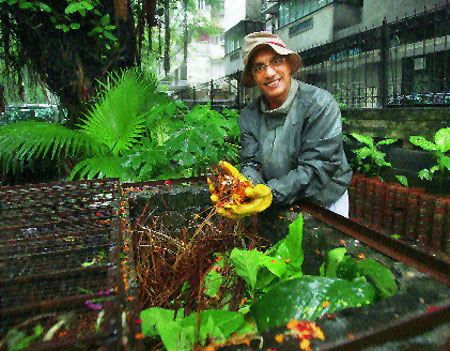|

|
|
|
http://www.hindustantimes.com/Entertainment/Luxury/Meet-the-real-green-card-holders/Article1-743960.aspx
In the company of trees
Anil Bhatia makes the immediate environment around him green and healthy through vermiculture and bio-composting. The soil in his garden is crawling with worms but that just means one thing: it’s rich!
mumbai
Anil Bhatia’s house is one of many apartments on D Road in Churchgate, Mumbai. The lane is well-known not only because it is located directly opposite Wankhede Stadium, but also because it has been labelled a ‘model road’ by Mumbai’s municipal corporation because of its cleanliness and greenery. However, what sets this lane apart from others is the 18 years of effort of the residents and the initiative of one resident – Anil Bhatia – to make it that way.
 A retired rubber technologist, Bhatia, 63, lives with his wife, daughters and grandson. The family started their eco-warrior journey by separating dry and wet garbage, which he says is a basic practice for an eco-friendly lifestyle. The wet waste comprising vegetable peels, fruit seeds and raw fruits and vegetables is used for bio-composting. Now every home in Bhatia’s building makes its contribution to the wet waste, which is used in the building’s garden. A retired rubber technologist, Bhatia, 63, lives with his wife, daughters and grandson. The family started their eco-warrior journey by separating dry and wet garbage, which he says is a basic practice for an eco-friendly lifestyle. The wet waste comprising vegetable peels, fruit seeds and raw fruits and vegetables is used for bio-composting. Now every home in Bhatia’s building makes its contribution to the wet waste, which is used in the building’s garden.
“The idea is not just to plant saplings but to take care of trees,” explains Bhatia. “Houses near healthy trees are automatically pest-free.” The soil of the plant or the tree needs worms to till it. This is vermiculture, wherein worms consume the waste and their excretion leads to nitrate fixation in the soil. If you visit his building’s garden, Bhatia will make you examine the soil and see the worms in it, indicating that the soil is rich in manure and nutrients.
The garden extends along the length of the entire lane. There are banyan trees, asoka trees, neem trees, papaya trees, mango trees, deodar trees and the list goes on. Three gardeners maintain it on a daily basis. “We have gardeners because the lane is long,” says Bhatia. “But you don’t need people if you’re doing this for your own house. Just take care to separate your waste and use the wet waste to make your own soil.”
What’s striking is Bhatia’s treatment of garbage. His family does not treat garbage like it’s dirty. “There’s nothing dirty about vegetable peels and their seeds,” says Bhatia. Their dustbin is a steel utensil, which is cleaned on a daily basis. It does not stink at all. “That’s because the stink starts when you mix dry waste with wet waste. Items such as paper and plastic need to be discarded separately.”
The building also uses bio-sanitised water. Bhatia, who interacts regularly with Dr Uday Bhawalkar, the director of Bhawalkar Ecological Research Institute in Pune, uses certain root enzymes given by Bhawalkar to ‘cleanse’ the water in his building. Three to four of these root enzymes, which are the size of green peas, can be used to balance the nutrient content of water in a way to make it fit even for drinking.
“Enzymes in trees’ roots help to make even dirty or saline water absorbed by the roots useful,” explains Bhatia. “Placing those enzymes in our water tank ‘cleans’ the water.” So much so that the gutter area of the building, where the waste water pipes are, doesn’t stink at all.
The effect of this bio-sanitisation has shown results in the health of the building’s domestic staff. Some of their children were perpetually ill but after consuming the bio-sanitised water, they’ve been much healthier. Moreover, because of this combination of healthy trees and bio-sanitised water, the Bhatias do not use phenyl or any other disinfectant to mop the floors of their pest-free house.
— Sharanya Misra Sharma
sharanya.sharma@hindustantimes.com
What you can do
- Segregate waste. Collect wet garbage and dry garbage separately
- Mix your wet garbage with the soil of your plants and trees. You will not need to add fertilisers if you do this
- Make your own soil. Use dry leaves, cow urine and waste along with wet garbage to create a compost pit. In about three months, it’ll turn into soil
- Try to avoid creating cooked waste. Never throw away cooked food, use leftovers creatively
- If you are composting, do not add artificial chemicals to your plants

|
 |
|
 |


 A retired rubber technologist, Bhatia, 63, lives with his wife, daughters and grandson. The family started their eco-warrior journey by separating dry and wet garbage, which he says is a basic practice for an eco-friendly lifestyle. The wet waste comprising vegetable peels, fruit seeds and raw fruits and vegetables is used for bio-composting. Now every home in Bhatia’s building makes its contribution to the wet waste, which is used in the building’s garden.
A retired rubber technologist, Bhatia, 63, lives with his wife, daughters and grandson. The family started their eco-warrior journey by separating dry and wet garbage, which he says is a basic practice for an eco-friendly lifestyle. The wet waste comprising vegetable peels, fruit seeds and raw fruits and vegetables is used for bio-composting. Now every home in Bhatia’s building makes its contribution to the wet waste, which is used in the building’s garden.